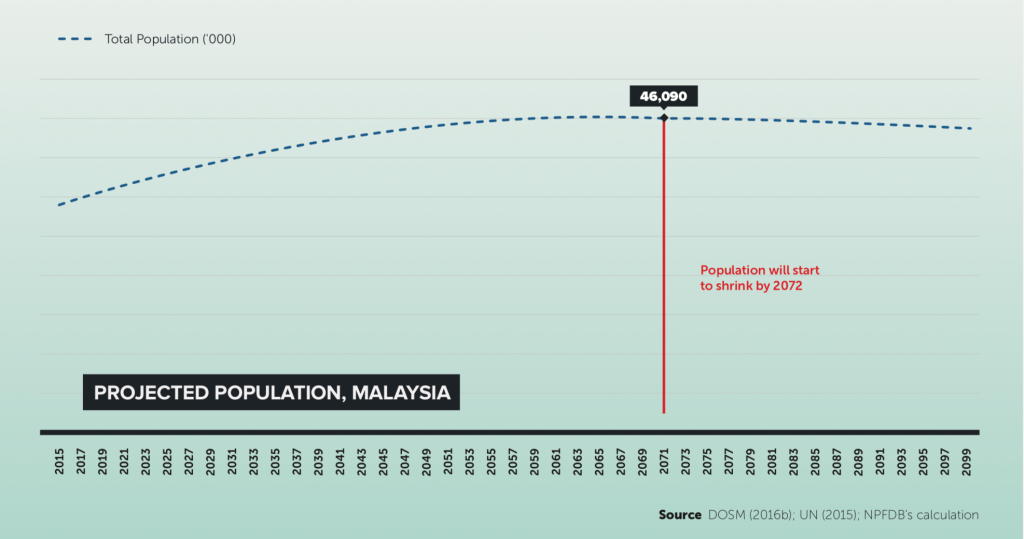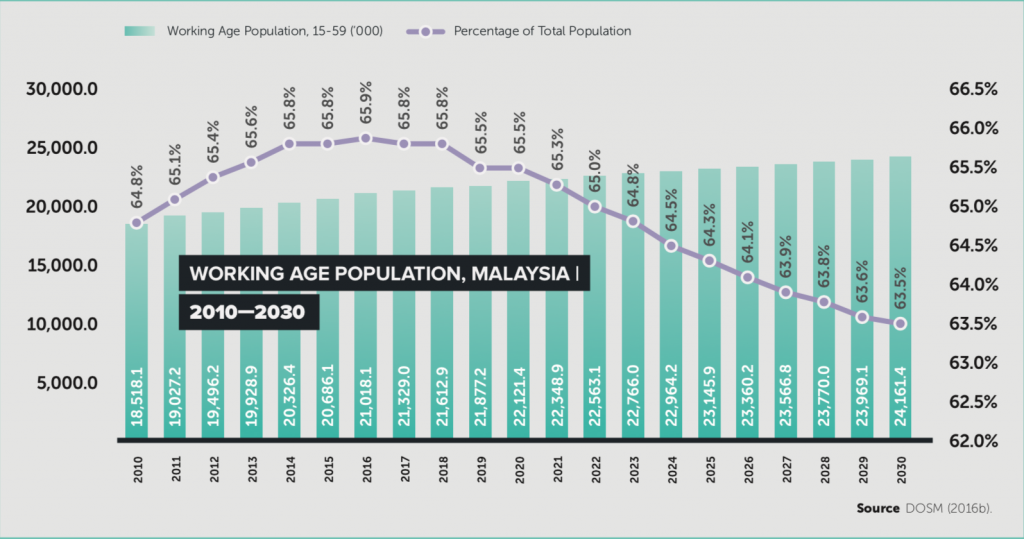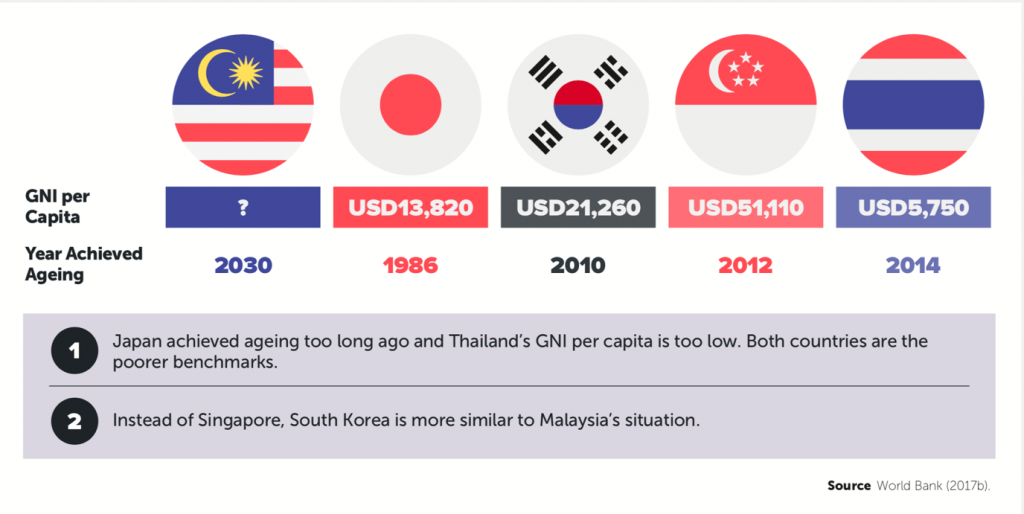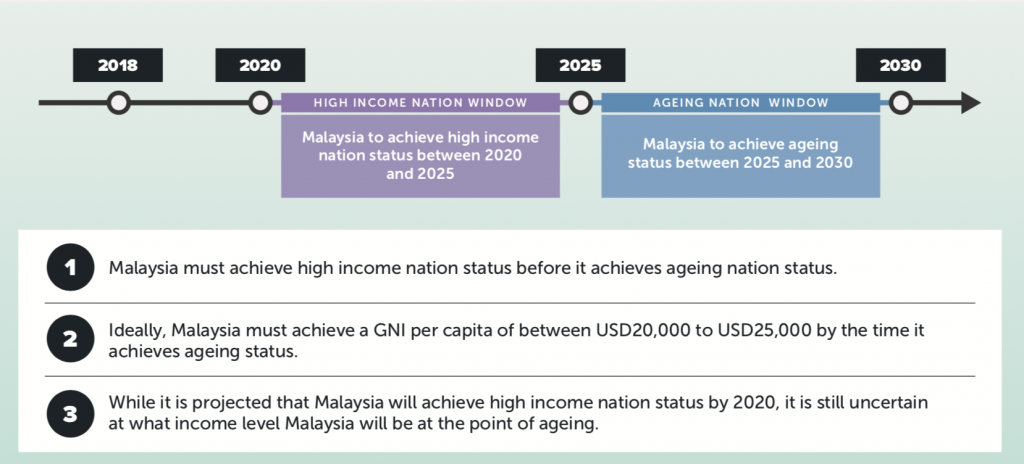Malaysia Population Research Hub

If the rate of fertility continues to decline with the current rate and there is no intervention taken to address the decline, the country will have the potential to undergo population shrinkage in 2072. It is projected that the population will continue to increase to reach the maximum of 46.09 million in 2071 before declining to 46.08 million in 2072.
The impact of this population contraction is that the quantitative goal of 70 million population targeted in the 70 Million Population Policy will not be achieved by the country by 2100. It is projected that the country’s population will remain declined to reach 44.58 million in 2100.

The Country will Experience Labour Shortages
Percentage of working age group (15 to 59 years) is projected to decline from 65.8% in 2017 to 63.5% in 2030, and will continue to decline by 2050. With the reduction in working age population, the country has to rely on foreign workforce to overcome the shortage of local labour.
If the fertility rate of the population drops steadily, the country will experience a contraction in labour force in the future. At present, most migrant workers in the country are from labour-sending countries such as India, Bangladesh, Philippines and Myanmar. However, by 2050, most of these countries will also experience ageing and contraction in the labour force. This will force them to retain their respective local workers from migrating to foreign countries such as Malaysia.
Therefore, it is important for the country to maximize the productivity of the working age population in the future by increasing the country’s labour force participation rate especially among women, youth aged 15 to 24 years and adults above 45 years of age. Currently, only 54% of women and 80% of men in working age groups join the labour market (DOSM, 2017b); about 10.5% of youth aged 15- 24 years are unemployed (ILOSTAT, 2016); and the participation rate of adult workers aged 45 years and over in the country is low (age 45-54 years old: 76.3%; age 55-64 years old: 49.4%) (ILOSTAT, 2015).

The Rapid Ageing Process will be a Challenge if The Country Does Not Have Enough Income, Malaysia 2010-2030
And as a preparatory period, the country needs to achieve per capita Gross National Income (GNI) between USD20,000 and USD25,000 by 2030 to enable the country to maintain its health expenditure at 7-8% of Gross Domestic Product (GDP) as has been done by South Korea which has reached “aged country” status in 2010. According to the Malaysia Economic Monitor, the country’s per capita GNI in 2017 is estimated to be at USD9,660 (RM39,407.97) (World Bank, 2017a).

High Productivity Must Become The Primary Drive Of Economic Growth From 2027 Onwards
The Eleventh Malaysia Plan’s focus on raising productivity and skills of the population comes at a right time, seeing as the country’s first demographic dividend is coming to an end. The first demographic dividend is defined as a period where the labour force temporarily grows more rapidly than the population that depends on it, caused by the economic transition from a predominantly agriculture society with high fertility and mortality rates to a predominantly urban industrial society with low fertility and mortality rates.
To offset consumer surplus from producers starting 2027 as a result of the ageing process, high productivity should be the main driver of the country’s economic growth. Increased productivity should begin by minimizing the mismatch between the skills and occupations performed by population in the country. In addition, the perception of Technical and Vocational Education Training (TVET) needs to be changed, and families play an important role in changing this perception.


This negative perception needs to be changed soon as the country will create more job opportunities related to TVET in the future. Under the Eleventh Malaysia Plan (RMKe-11), 1.5 million jobs will be created by 2020 and 60% of them will be based on TVET skills.
